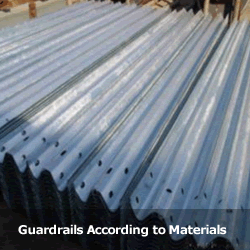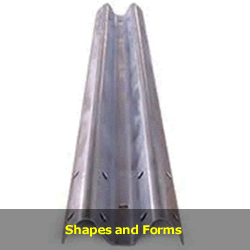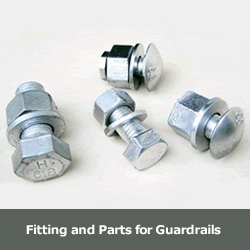HIGHWAY MEDIAN GATE BARRIERS AND MISCELLANEOUS MATERIALS
We supply median steel gate meeting American and other standards for the highway guardrail barrier systems. Together with the gate materials, we also supply shop drawings and method of installation for construction of the Median gate barrier, with full details for the gate and connection to the median barrier.
What is Median Gate Barrier?
Median Steel Gate is a longitudinal redirecting barrier used as a Gate to provide an opening for emergency access. A vertical steel pivot pin will be used to interlink each module allowing the system to follow curves of up to six degrees per four meter segment. The Gate is incorporated into a long run of steel barrier. The Gate sections are easily raised and lowered with manual jacks with attached caster wheels. The Gate shall be a crashworthy longitudinal barrier, which opens to varying lengths depending on the number of its sections.
Construction of Median Gate Barrier / Emergency Opening Gate
1, The gate is supplied in common size of 12 m, constructed of 3 segments, while various size options available.
2, The sections are placed at the center of an opening in median barrier to form a continuous longitudinal barrier. The segments are pinned together and easily unpinned and moved to form an opening for vehicle access.
3, The Gate is capable of integration to longer runs of temporary or permanent longitudinal steel barrier installations.
4, Gate sides: The sides of the gate assemblies shall be constructed of AASHTO M180 thrie-beam panel and lower skirt sections. The thrie-beam and lower skirt sections shall have sufficient tensile strength to resist design speed vehicle impacts.
5,
Surface: Exterior and most interior surfaces shall be corrosion resistant per ASTM A-123.
6, Gate system ends:
The outermost ends of the Gate segments shall be equipped with hinged and transition sections that attach to median.
7,
Each segment shall be equipped with wheels attached to jacks to allow the segments lifted and rolled as required.
8, Hinges:
The hinge section shall be secured from rotation by the use of a single steel pin. Operation of the hinge shall be accomplished by removing the center hinge pin, installing the small latch hinge pin at the base of the hinge section and then pushing the Median Gate sections in the desired direction. The transition sections shall be anchored to the roadway. The gate segments shall be capable of being opened from either end, from the middle, or be completely removable and rolled out of the opening. The hinge sections shall allow the gate segments to swing 90° in either direction.
Why buy from us ? We supply Quality Guaranteed High Performance Median Opening Barriers for Your Highway Security Barrier System
Performance Criteria - Median Steel Gate System meeting NCHRP 350 TL-3 test requirements
Our steel gate barrier is fully tested to meet the recommended structural adequacy, occupant risk, and vehicle trajectory criteria set forth in the National Cooperative Highway Research Program Report 350 for the Test Level 3 for Longitudinal Barriers, impact conditions of 820 to 2000 kg vehicles at speeds to 100 km/h and angles up to 25 degrees when properly installed according to the manufacturer's recommendations.
Our gate can be used preventing vehicle penetration, vaulting, and under riding during Test Level 3 Length Of Need with Transition (TL-3 LON/T) impacts and can smoothly redirect the vehicle. For TL-3 LON/T impacts, detached debris shall not show potential for penetrating the vehicle occupant compartment or present a hazard to other traffic, pedestrians or workers in a work zone. The vehicle shall remain upright during and after the collision. Moderate rolling, pitching, and yawing may occur. The impact velocity of a hypothetical front seat passenger against the vehicle interior, as calculated from the longitudinal vehicle acceleration and 600mm forward displacement, and the lateral vehicle acceleration and 300mm lateral displacement shall be less than 12 m/s. The highest 10 ms average vehicle acceleration in the longitudinal and lateral directions subsequent to the instant of passenger impact shall be less than 20 g's. The gate shall be fully operational after minor impacts and must remain a positive physical and visual barrier before and after design speed impacts. The gate shall be resistant to jamming and/or severe debris buildups.
Miscellaneous Materials for Highway Median Gate Barrier: Reinforcing Wire Mesh, Fasteners, Waterproof Memberance, Tiles and etc.
We supply quality miscellaneous materials for construction of median gate barrier in highway projects, including and not limited to the following: waterproofing membranes used in concrete parts, ceramic tiles, grouts and wire mesh reinforcement.
Wire Mesh Reinforcement - U. S. Standard
Galvanized welded steel wire fabric
Opening: 5cm by 5cm square
Wire: 16 ga.
Fasteners
Standard velocity fasteners, 31.75mm long by 3.57mm diameter shank, tempered steel drive screws
Standard:
U.S. Federal Specifications FF-P-395 and QQ-Z-325.
Supplied with 38mm diameter galvanized sheet steel washers for use with each drive pin in fastening wire reinforcement.
Cements
Cement shall be Portland Cement complying with ASTM C150, Type V.
Aggregate shall be washed, sharp, natural sand complying with ASTM C144. Rounded shape sand will not be acceptable.
The mortar bed 15mm thick (-2 and +5mm) with styrene butadiene rubber (SBR) emulsion additive.
| Sand 5.0mm (max) | natural | As per BS 882 |
| Cement | SRC | ASTM C-150 |
| Compressive Strength (N/mm²) |
28 days | =27.0 |
| Tensile Strength (N/mm²) | 28 days | =2.5 |
| With at least 70.0% strength recovery in 7 days | ||
Tiles
Tile adhesive shall be cementitious with a thickness of 3.0 mm±1.0mm.
| Compressive Strength (N/mm²) | 1 day | =5.0 |
| Tensile Strength (N/mm²) | 3 days | =1.5 |
Tile Grout. Grout shall be cementitious and have the following properties.
| Compressive Strength (N/mm²) | 1 day | =4.0 |
| Tensile Strength (N/mm²) | 28 days | =2.7 |
Joint Sealant. Sealant for application at 15 and 30 mm wide expansion joints shall be a multicomponent, non-sag expoxidised polyurethane complying with U.S. Federal Specification TT-S-227, Type II, Class A, a9-GP-24. Sealant for application at 10 mm wide control joints shall be single component acrylic terpolymer complying with U.S Federal Specification TT-S-230, non-sag, 19-GP-5b, AAMA 808.3; or single component polyurethane complying with U.S Federal Specification TT-S-230, Type II, Class A; or single component silicone complying with U.S Federal Specification TT-S001543, class a or TT-S-230, Type II, Class A, 19-GP-9M. Colours are dark brown or dark bronze as approved by the Engineer.
Debonder. Debonders shall be bituminous or tar based paint (two coats) .
Waterproofing and anti-fracture membrane
Waterproofing and anti-fracture membrane shall be used in wet tiled areas and shall be thin, cold applied, load bearing and non-toxic. The waterproof membrane shall be resistant to urine, dilute acid, alkali, sugar, brine, and food waste products.
Reinforcing fabric shall be nonwoven rot-proof fabric specifically for use with waterproof membrane.
All materials are non-toxic, non-flammable, and non-hazardous during storage, mixing, application and when cured.
Waterproofing, crack suppression and anti-fracture membranes shall meet the following physical requirements:
Water Permeability - (at 30ft.hydro/0.9 atmos/91.2kPa) Nil
Elongation at break - (ASTM D-751) 40%
Service Temperature - -20°to+280°F(-28°to+137°C)
Tensile breaking strength - 2950psi
(20.4MPa;207kg/cm²)
thickness - 20 mils (0.5mm)
Bond strength to concrete - 350psi (2.4MPa;24kg/cm²)
Resistance to chemicals (90 day immersion):
Brine solution - Not Affected
Sugar solution - Not Affected
Milk - Not Affected
10% Acid - Not Affected
10% Alkali - Not Affected
Rubber solvents or ketones - Not recommended
Calcium Chloride - Excellent
Aromatic Solvents - Not Recommended
Floor Tile Installation Evaluation (ASTM C627-81)900 cycles
Service Rating (TCA) - Extra Heavy Duty





